There are 40 councillors on this council.
The main focus of attention will be the struggle for dominance between Sinn Féin and the SDLP, especially in those District Electoral Areas (DEA’s) lying in the constituency of Foyle. SF took a hammering at the 2019 council elections, although little of the spoils went to the SDLP. Subsequently, in the Assembly election, while the SDLP held almost all of its vote in Foyle and West Tyrone, Sinn Feín’s performance was poorer – losing 3.8% vote share in Foyle, its worst performance at that election.
This council is critically important for the SDLP. It simply cannot afford a bad performance here. If it looks to be faltering in Derry the questions over its future, and especially over its leader, will multiply.
On the outgoing council both the SDLP and SF won seats in all seven District Electoral Areas (DEA’s). The DUP took seats in 4; the UUP, Alliance and PBPA in 2 each; and Aontú in 1. Four of the DEA’s also elected Independents. Nationalists have by far the biggest vote share, although both they and unionists lost share to ‘others’. Half of the increase in ‘others’ came from PBPA.
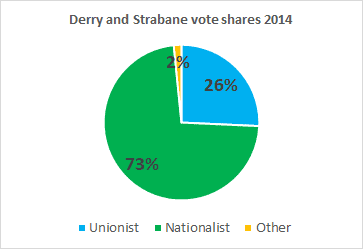
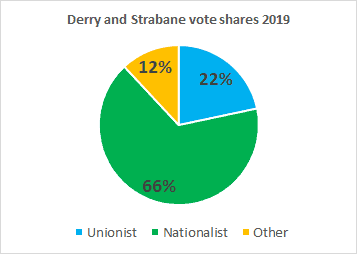
The nationalist vote includes four Independent councillors. Details will be found within the individual DEA sections.
The full make-up of the council in 2014 and 2019 can be seen in the chart below.
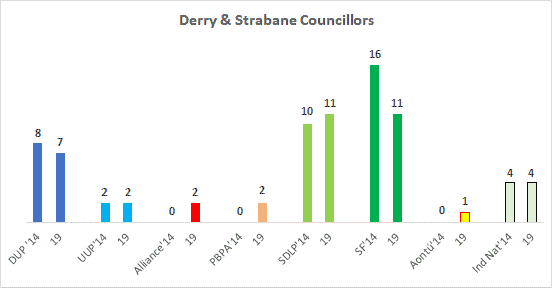
Eight seats changed hands.
Aontú took a seat (their only one in Northern Ireland) in Ballyannett which had previously been held by an Independent who did not contest the election. SF lost seats to PBPA in Foyleside and also in The Moor, to the SDLP in Derg, and to an Independent in Sperrin. Alliance took a seat from the DUP in Waterside and from the SDLP in Faughan. There was also an Independent to Independent change in Foyleside.
The main changes in vote share were the 8% point fall for SF, and the 6% point increase for PBPA. Alliance recorded a 3% increase.
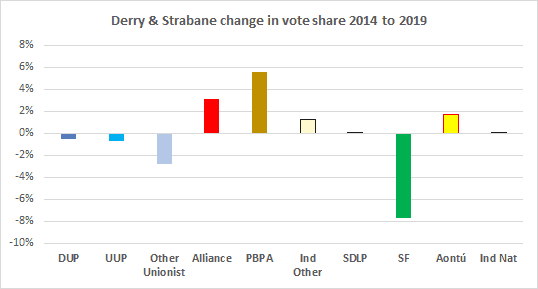
The Other Unionists were TUV, PUP and UKIP none of whom contested the last election.
Comparing the 2019 council votes with the 2022 Assembly votes in Foyle and West Tyrone raises high hopes for Sinn Feín, up 7% points and 9% points respectively, while the SDLP held their share in both. However, there is a gravitational pull towards the larger parties at Assembly elections and the vote for nationalist independents was far lower than for the council. While the Independents could take votes from both parties, the last council election suggests that they pose a bigger threat to Sinn Feín.
The PBPA vote was down 3% points in Foyle – and this is a loss they cannot afford to repeat in these elections.
The DUP dropped 3% points in both constituencies, with the UUP picking up the slack in Foyle. But in West Tyrone the UUP lost badly – down 7% points. The big unionist gainer here was the TUV up 9%.
Alliance was slightly down in Foyle (-0.5%) and up 2% in West Tyrone.
Outlook by DEA
As well as giving the historical data for the last election in 2019, each table contains two projections.
The first, headed ‘Based on Ass’22’, shows an estimate for the change in the party quota based on the change in its vote between 2019 and 2022 in the relevant constituency or constituencies. I then show where this might put a seat under threat or present a possible gain.
The second projection is changed in the light of the headline figures in the latest Lucid Talk poll. However, since the detailed tables are not published until later, I have been unable to use some of the information I normally rely on.
I have departed from the Assembly vote and the Lucid Talk poll in one respect. I have assumed that Independents who were elected in 2019 will hold onto all or most of their vote in this election, based on the tendency for this to happen in previous council elections.
Please remember that this is not intended to be a prediction. In contrast to my conservative treatment of Independents seeking re-election, I have included party gains and losses which are a long shot, as well as those which are more likely. This is to reflect the degree of uncertainty inherent in making these estimates. Treat them as a guide as to what to look out for, or for making your own judgements.
My Best bet for each DEA is just a bit of fun. It is too simplified to capture all the possibilities and may therefore be wrong as often as it is right.
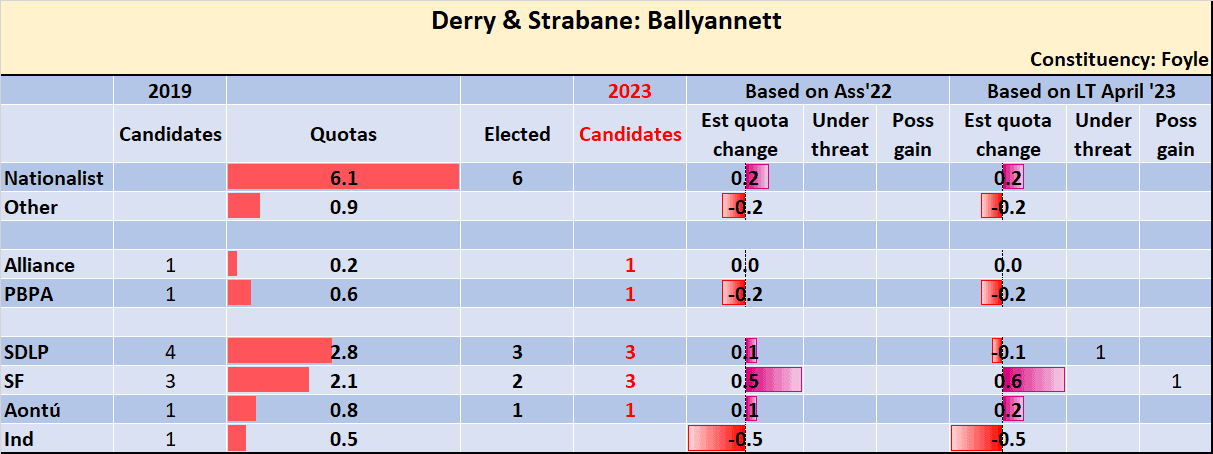
Four of the six outgoing councillors are standing again, one of whom was co-opted (Aontú). One SDLP and one SF have bowed out.
Sinn Feín and the SDLP could be neck and neck here. Last time SF’s balancing was far tighter – which is a major advantage when things are close. On the other hand, Alliance transfers favoured the SDLP more than 4 to 1 over Sinn Feín. And in the Foyle Assembly election Aontú voters favoured the SDLP by nearly 2 to 1.
Best bet: No change

Three of the five outgoing councillors have put their names forward again. The exceptions were the SDLP and one SF.
PBPA got 0.8% in West Tyrone Assembly election, and Aontú 1.4%. Neither are likely to be in the running.
The SDLP candidate could be in trouble here. A well-balanced Sinn Feín trio could overtake him, although it is possible that unionist and ‘other’ transfers could carry him home. But not if he is behind the Independent Patton, who might attract many of those transfers instead. Patton was runner up last time. His platform was all about Sion Mills. If he can spread his appeal a little wider then he has a chance of taking the SDLP seat himself.
Best bet: No change
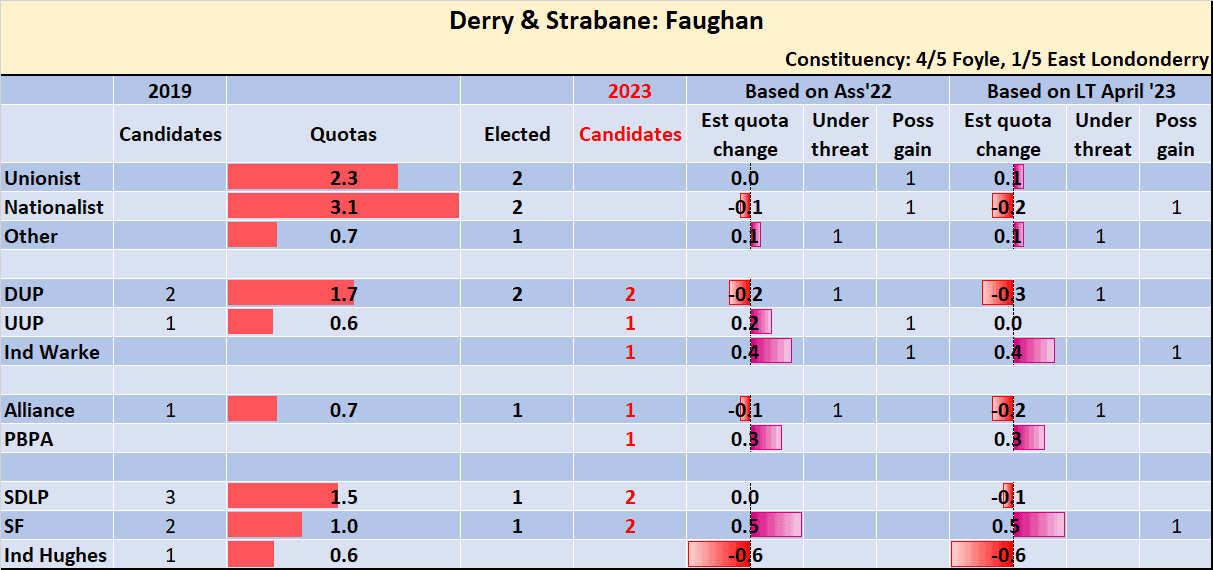
Each of the five outgoing councillors is standing again, although the SDLP and Sinn Feín representatives were both co-opted.
The Independent Paul Hughes, who stood in 2019 but has not entered the contest this time, told the Derry Journal “I am neither ‘orange’ nor ‘green’ and refuse to be pigeon-holed as simply ‘other’”. The record shows that over half of his votes did not transfer, but those that did were overwhelmingly nationalist.
During the course of the four-year council term the DUP lost both their Faughan councillors. Graham Warke resigned from the party in 2022 at the end of his year as Mayor saying he wanted to pursue “a moderate, progressive and positive political pathway”. He is contesting this year’s election as an Independent. Warke won 0.9 of a quota as a DUP candidate in 2019. I am guessing he takes between 0.3 and 0.4 of a quota this time – probably in roughly equal measure from the DUP and UUP.
Ryan McCready moved to the UUP and stood for that party in the Assembly elections for Foyle, coming within 100 votes of taking the final seat from the DUP’s Gary Middleton. He will be standing again.
To recap, we have 2 former DUP councillors taking on 2 new DUP candidates; last time’s runner-up, an Independent no less, not in the race this time; and the entry of the PBPA who could take votes (how many?) from both nationalists and ‘others’. Would you like to analyse this one?
Since the PBPA had no candidate here last time I have assumed that their vote will be about a quarter to a third of a quota – based on their performances in Derry.
It should be tough for the DUP to retain two seats, but with the ex-DUP Warke possibly competing as much for UUP votes as for DUP ones, we could see the DUP’s opponents splitting the non-DUP unionist vote. Warke or McCready’s voters would be very unlikely to transfer totally to each other. At least half would probably go to the DUP.
Sinn Feín have a distant prospect of second seat, but in the current climate the SDLP almost certainly do not. SDLP transfers would probably favour Alliance as much, or a bit more, than Sinn Feín – while SF would have to divide them between two candidates.
Alliance will be in a tough fight to retain their seat, but have more potential sources of transfers.
Best bet: no change
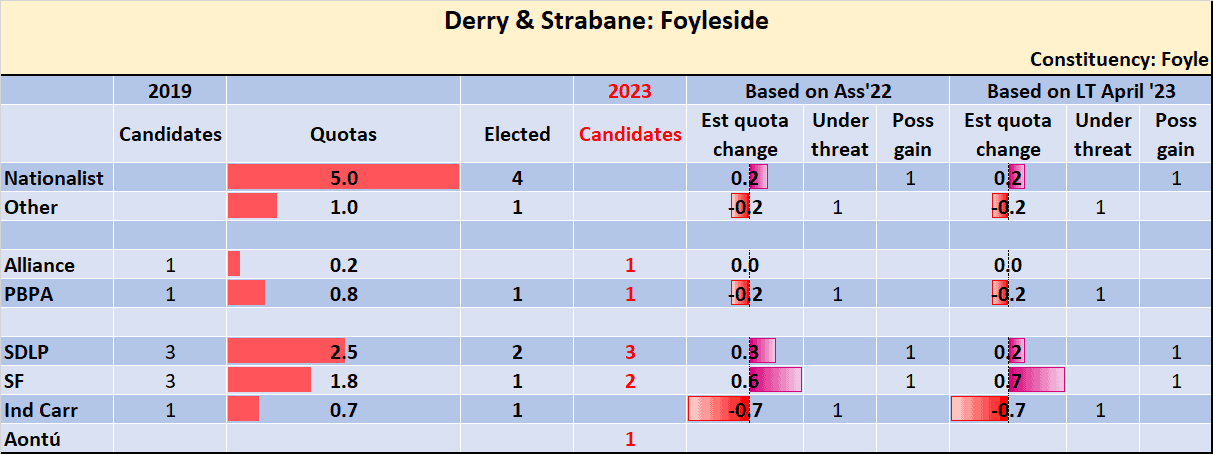
Only two of the outgoing five councillors want to continue, the PBPA and one SDLP.
With the Independent Sean Carr out of the running this time, there is any easy gain available for someone. Sinn Feín look to be very well placed. However, Carr was an SDLP councillor from 2001 to 2015 when he resigned from the party. His vote may favour the SDLP more than my model suggests.
The recent weakness of the PBPA vote, if replicated here, could put a question mark over their seat, so the SDLP might well make a gain anyway.
Aontú are an unknown quantity, not having contested the DEA last time. However, even if they make a decent first preference showing their problem is likely to be getting transfers.
Best bet: SDLP and Sinn Feín each take a seat from PBPA and the vacated Independent.

Two Independents were elected in Sperrin last time and are standing again. Paul Gallagher first stood for election in 2011 for the IRSP and was successfully elected as an Independent in 2014. He describes himself as a “an Irish republican socialist”.
Raymond Barr, who has been described as a left of centre republican, has served one term on the council.
In all five of the seven outgoing councillors are in the contest, but Sinn Feín are fielding new candidates.
There is a third Independent candidate. Patsy Kelly is a former SDLP councillor who stood unsuccessfully as an Independent in 2019.
If the TUV had stood they might have had a chance of taking one of the DUP seats. As it is, if there continues to be two unionist seats they will remain in DUP hands. However, since there may not be two full unionist quotas a question mark must hang over that second seat. What will almost certainly save the second DUP is the plethora of non-unionist candidates in the field. Each time one is eliminated or elected some of their votes do not transfer. By the end of the last count in 2019 half a quota’s worth of votes had become untransferable.
If the second DUP seat did fall it could be picked up by either the SDLP or Sinn Feín. Sinn Feín could be much nearer on first preferences, but the SDLP would be more transfer friendly to Alliance and PBPA voters.
Of course if either Barr or Gallagher stumbles the whole dynamic would be altered.
Best bet: No change

Three of the five councillors elected in 2019 are standing again, plus a co-opted Sinn Feín.
The PBPA will be without Eamon McCann this time. They are unlikely to hold all of his personal vote.
Also absent this time will be any unionist candidate. This will probably mean that some of those unionist voters will not come to the polling stations. Those that do will probably vote largely for Alliance, although on past form quite a few could go for the SDLP.
Gary Donnelly is the Independent member up for re-election. He has served on the council since 2014. He has been associated with the dissident republican movement, but called on the New IRA to end all attacks after the murder of Lyra McKee.
Sinn Feín look likely to make a strong bid to take the PBPA seat. However, with the number of nationalist candidates on the ballot paper, and Aontú in the mix, this will increase the possibility of PBPA holding on long enough to attract transfers. This will be especially true if either SF or the SDLP fail to balance their candidates well. Last time the SDLP did not balance, and Sinn Feín were not at their impressive best.
Best bet: No change
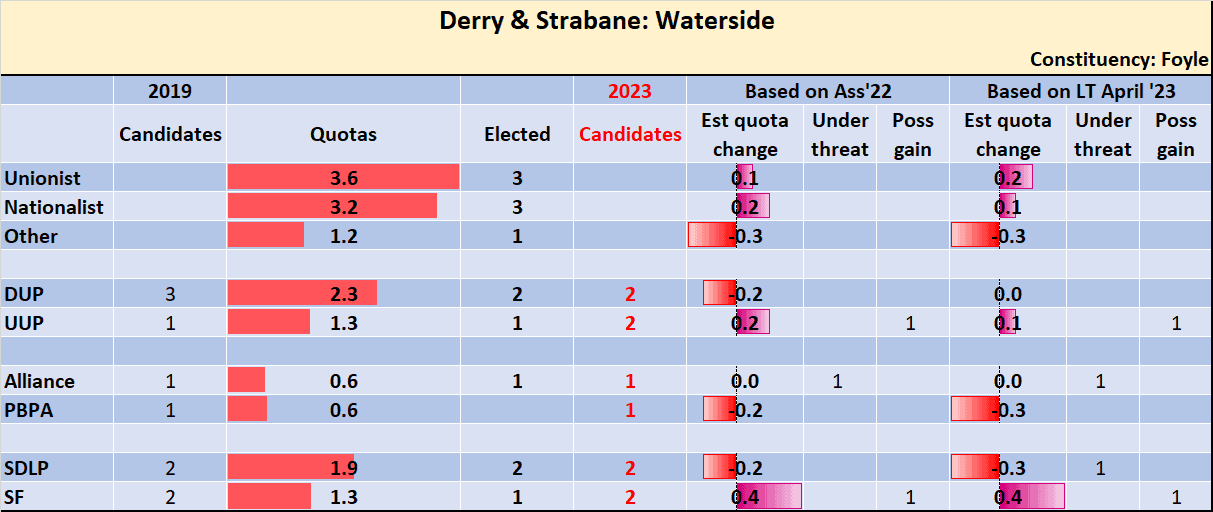
Of the seven outgoing councillors three will not be standing again. Both DUP members and one of the SDLP’s are bowing out.
The SDLP and Sinn Fein could be sitting on similar numbers of votes after the first count. If so balancing will be crucial. Last time out SF balanced their two candidates well. The SDLP did not. If that happens again Sinn Feín will be in with a chance of taking the second SDLP seat. But they would need transfers to seal the deal, and these could be in short supply. Since the UUP are running two candidates this time, they would have a long-shot chance of winning the SDLP seat instead.
There is a different, but tortuous, route to a UUP gain. If they increase their vote by the amount estimated here, and if they balance perfectly, and if the SDLP have also balanced well, then – if both candidates are ahead of Alliance – they could the Alliance seat. But that is a lot of conditions to be fulfilled with an uncertain reward at the end of them.
Best bet: No change
Michael Hehir is a retired sales and marketing manager. He studied in Northern Ireland but now lives between England and Italy.
Discover more from Slugger O'Toole
Subscribe to get the latest posts to your email.
